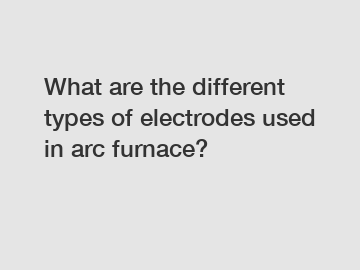What are the different types of electrodes used in arc furnace?
What are the Different Types of Electrodes Used in Arc Furnace?
Arc furnaces are widely used in various industries such as steelmaking, foundries, and metal recycling. These furnaces rely on electrodes to create an electric arc, which heats the materials and melts them down. The type of electrode used in an arc furnace is crucial as it affects the efficiency, performance, and cost-effectiveness of the process. In this article, we will explore the different types of electrodes commonly used in arc furnaces and their characteristics.
Graphite Electrodes.

Graphite electrodes are the most widely used type of electrodes in arc furnaces. They are made from a mixture of petroleum coke and coal tar pitch, which is then molded and baked to form the electrodes. Graphite electrodes have several advantages that make them a popular choice. Firstly, graphite has high electrical conductivity, allowing for efficient energy transfer during the melting process. Additionally, graphite electrodes have good resistance to thermal shock and high melting points, making them suitable for high-temperature operations. Graphite electrodes also exhibit low consumption rates, meaning they last longer before needing replacement.
The main drawback of graphite electrodes is their relatively high cost compared to other types. However, their superior performance and longer lifespan often outweigh the initial investment. Graphite electrodes are commonly available in sizes ranging from small to extra-large, catering to different arc furnace capacities and requirements.
Carbon Electrodes.
Carbon electrodes are another type commonly used in arc furnaces. They are made from a mixture of petroleum coke and coal tar pitch, similar to graphite electrodes. However, carbon electrodes differ from graphite electrodes in terms of the baking process. Carbon electrodes undergo a lower-temperature baking process, leading to a higher carbon content. This difference in baking process gives carbon electrodes their unique characteristics.
Compared to graphite electrodes, carbon electrodes have slightly lower electrical conductivity. This leads to lower energy transfer efficiency during the melting process. However, carbon electrodes are more cost-effective due to their lower production costs. They are often used in smaller-scale arc furnaces or in applications that do not require high thermal efficiency.
Composite Electrodes.
Composite electrodes, as the name suggests, are a combination of different materials. They are typically made by mixing graphite or carbon with other materials such as metals or ceramics. The addition of these materials brings additional benefits to the electrodes, enhancing their performance in specific arc furnace applications.
Composite electrodes can be tailored to meet specific requirements, such as high-temperature operations or improved electrical conductivity. They offer better resistance to thermal shock and can endure higher mechanical stress. Composite electrodes are often used in specialized arc furnace processes where standard graphite or carbon electrodes may not perform optimally.
Conclusion.
In conclusion, the type of electrode used in an arc furnace plays a vital role in its efficiency and performance. Graphite electrodes are widely preferred for their high electrical conductivity, thermal shock resistance, and prolonged lifespan. Carbon electrodes offer a more cost-effective solution, although with slightly lower electrical conductivity. Composite electrodes provide a customized approach, incorporating different materials to enhance specific properties as needed.
When considering the type of electrode to use in an arc furnace, it is essential to evaluate the specific requirements of the process, such as melting capacity, energy efficiency, and cost-effectiveness. Consulting experts in the field can help determine the ideal electrode type based on the furnace's specifications and operational goals.
For further information or professional assistance regarding arc furnace electrodes, please do not hesitate to contact us.
If you want to learn more, please visit our website KFCC graphite electrodes, Kfcc Graphite Electrode, Kfcc Graphite Electrode.

Comments